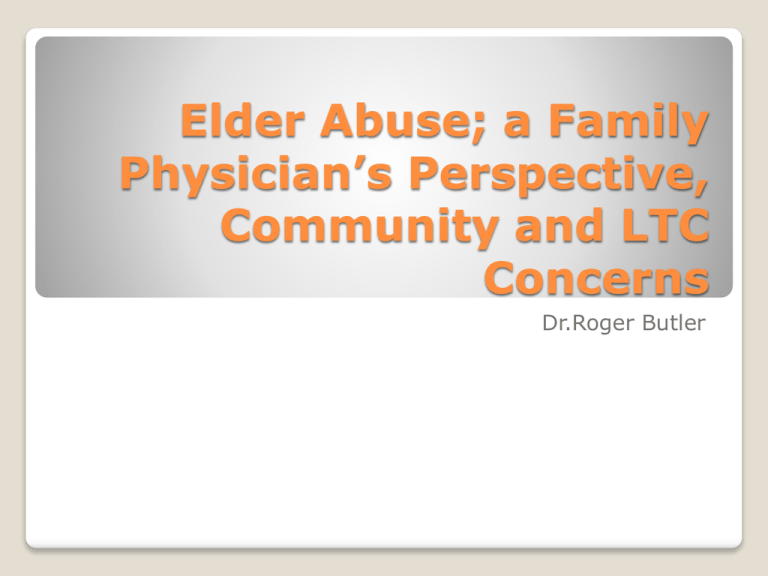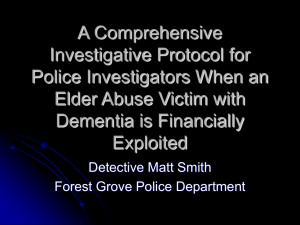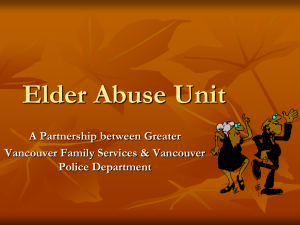Dementia and Elder Abuse
advertisement

Elder Abuse; a Family Physician’s Perspective, Community and LTC Concerns Dr.Roger Butler A war veteran / VP resident Discuss current research on elder abuse demographics in relation to dementia care Discuss some theoretical models to explain WHY? Explore challenges in dementia care both in the community and LTC sectors Explore barriers physicians face in elder abuse Explore characteristics of caregivers,residents and the environment that predispose to elder abuse What can physicians do? Objectives Elder abuse has been defined by the World Health Organization (WHO) as a single or repeated act ,or lack of appropriate action, occurring within any relationship where there is an expectation of trust and which causes harm or distress to an older person. Definition Elder abuse is any act or failure to act, within a relationship where there is an expectation of trust, that jeopardizes the health or well-being of an older person. Neglect is any inaction ,either intended or unintended , within a relationship where there is an expectation of trust, that causes harm to an older person. Elder Abuse and Neglect Physical – violent act or rough treatment causing injury or physical discomfort. Also includes sexual and medication abuse. Psychological or Emotional Abuse – an act that may diminish the sense of identity ,dignity , or self- worth of an individual. Financial or Material abuse- theft or misuse of a senior’s money or property Types of Abuse The failure to meet the needs of an older adult who cannot meet their needs on their own. It may have physical , financial or psychological components. Two Types; ACTIVE and PASSIVE ACTIVE: intentional withholding of basic necessities and /or care PASSIVE: non-intentional ,non-malicious withholding of basic necessities and /or care because of lack of experience, information ,or ability Neglect The older person is living in an unsafe or unhealthy manner by choice or ignorance. What to do if you are worried? Self Neglect 2031, 25% Canadian population>65 (8 million) Elder abuse or neglect 7% In 1999 researchers found that: -7% respondents reported emotional abuse -1% reported financial exploitation -1% reported physical or sexual abuse At least 1/3 are family members It affects all demographic groups (Dept of Justice Canada) Elder Abuse Demographics You have just began your shift at the new LTC facility in St. John’s. The staff at the nursing station are having a discussion on how they are going to deal with a new resident with aggressive behaviour. One of the senior LPN’s says “ Once we get him into our routines everything will be just fine”. What is your immediate reaction? LTC setting scenario 5-55% compared to 3.2-27.5% prevalence rates for nondemented ( Cooper et al US data) Elders with dementia have highest incidence of mistreatment and abuse in LTC...12% (9 year study 2003 Levine) Many cases unreported ½ nursing staff reported abuse towards resident in past year and 70% witnessed other staff commit act (Israel LTC study 2010) Mental abuse and neglect most common Elder Abuse and Dementia Study based on 22 nursing homes in Israel and published in 2010 (International Nursing Review) Random selection from 300 nursing homes in Israel 10 workers per site in various departments at various times of day Gov’t, site admin and ethics approval Staff confidentiality assured 85% staff response rate Psycho-social factors affecting elders maltreatment in LTC facilities Details of the facility, demographic details and professional details Reporting incidents of violence, victim traits, attitudes towards and knowledge about maltreatment Burnout questionaire Areas studied 1. Theoretical model for predicting causes of elder maltreatment in LTC facilities(Pillemer 1988) working model looking at institutional work environmental factors, staff traits and resident traits as interrelated causative factors. 2. The theory of reasoned action(Ajzen and Fishbein) 1980) Human behaviour depends on two components; behavioural attitude and subjective norms Models for Abusive behaviour Young female nursing aids (less training) more likely Longer working staff with positive attitude less likely Improper care associated with job pressures and staff burnout Worker burnout associated with physical and mental violence Staff Traits Staff who perceive the following are at risk: - residents have to be constantly served -they are waiting to die -they behave like little children -they must be occasionally taught discipline Staff Traits continued Elderly residents with dementia have the highest risk of abuse of all disabled people Aggressive resident behaviour is related to physical and verbal abuse by the caregiving nursing staff Women residents have the highest risk of abuse because they are probably most vulnerable Rate increases with age in the LTC and home environments Socially isolated are at greater risk Patient Traits More prevalent in profit seeking facilities (Iowa 2006) Low staff ratio and high staff turnover leads to high risk compromise in quality care and subsequent high risk for elder maltreatment Lack of nursing staff leads to elder maltreatment (California/Scandinavia Non-profit facilities provide the best nursing and medical services Facility features ½ staff report abusing residents in the previous year 2/3 of abuse involves physical and mental neglect Psychologically staff perceive neglect as an act of omission and therefore maybe seen as a systemic failure of the system rather than a personal one to provide basic needs. These do not involve personal motives or malicious intent hence easily reported Results Jewish moral custom of honouring seniors not perpetrated the nursing home culture Significant positive correlation between staff burnout and physical violence and mental abuse. Greater staff emotional fatigue and depersonalization greater maltreatment risk Less ambition in the workplace correlates with greater risk of maltreatment as well Burnout creats a neg attitude to job and elderly residents and lack of empathy and vise versa Results Continued Nurses aids and practical nurses had more manifestations of elder maltreatment Surprising in this study more work experience correlated with a higher risk of abuse The more one witnesses abuse the more one is likely to perform abusive acts No correlation found with academic knowledge, clinical knowledge,seniority,attitudes to maltreatment ,gender and age of workers Results Continued Elderly demented females higher risk of mental abuse Aggressive residents have 4x the risk of maltreatment Results Continued Need for periodic, structured and regular training of caregiving staff, mainly practical nurses and nursing aids unrelated to their professional seniority….highlighting difficulties with caring for demented residents, coping under pressure and managing feelings and attitudes towards residents. Staff support groups Establish enforcement systems within the facility Periodic exams with extrinsic government systems Bottom Line Interprofessional Patient Care Team We can change our behaviour towards a dementia resident but the dementia resident is usually not able to change how they react to us. Severely demented residents read body language and reflect body language behaviour. Distraction maneuvers which utilize resident procedural memory are highly effective in crisis management. What we must know about dementia care? ABC… for the resident Antecedent, Behaviour and Consequences P.I.E.C.E.S …for the caregiver Assess caregiver physical health, intellectual health, emotional health, capabilities, environment ,and social supports. ( the secret of caring for the resident with dementia is caring for the caregiver… Alzheimer society) Aggressive Behaviour Management Age 86 with Alzheimer’s type dementia who has his daughter and her family living with him because they were unemployed and he needed help. He has been agitated recently and requires some assistance with dressing. He tends to pace and follow his daughter around the house repeatedly asking her questions. Mr. Duddleberry His daughter Shirley brings him in for his appointment .It is clear she is unhappy and resentful. You ask your nursing assistant to bring him into your exam room and you take his daughter aside. You acknowledge she looks depressed and ask “How are things going?” Shirley relates how her father was never around when she was growing up and now he needs help he has come back into her life and is ruining it. She finds she can’t spend time with her kids , her husband is annoyed and you smell a faint smell of alcohol on her breath. Duddleberry Case The family physician is in an ideal situation to recognize that this is a potentially abusive situation. It will require listening time, supportive counselling or referral, linking with the Alzheimer’s society, and looking at respite, day care options to prevent burnout in this caregiver. Victim 1. Advanced age 2. Dependency for basic activities of daily living 3. Dementia 4. Combative behaviour Perpetrator 1.Depression/Mental illness 2.Alcohol or drug dependency 3.Financial dependence 4.Caregiver complaining about the patient Risk Factors for Elder Abuse Estimated rates of abuse by caregivers is 5-14% in the dementia population as compared to 1-3% in the general population Financial exploitation was estimated to affect 20% of victims of elder mistreatment ( US 2003 National Aging Resource Centre on Elder Abuse) Home Based Abuse 62% all forms in 1 month (122 family caregivers) Verbal>physical 62%vs 18% More coresiding days> violent episodes High level of agitated behaviour predicts verbal abuse Agitated behaviour may elicit abusive behaviours though it’s effect on caregiver burden Family Dementia Caregiver Study Hong Kong: Int J Geriatric Psychiatry Aug 2010 Elderly patients visit their family physician 5X per year Only 2% report cases of abuse or neglect Family physicians are champions of child abuse identification Why the lack of identification of elder abuse by family physicians? Failure of victim to corroborate the abuse. Fear of retaliation by a family member Unwillingness to become involved with adult protection services Discomfort with the problem Time /remuneration constraints Not knowing the signs and symptoms of elder neglect /abuse. Not a member of the community team Why? Improve exposure in medical school to elder abuse. Increase geriatric education as mainstream in today’s medical environment Push for mandatory reporting of elder abuse. Instruct graduation physicians in the use of screening tools such as the EASI for identification of potential elder abuse victims. Be aware of the dementia syndrome, able to diagnose the common types and address the behavioural issues using evidence based approach. Work interprofessionally with the schools of Nursing,Pharmacy,and Social Work for common curriculum in Elder abuse. What can we do in the medical profession? Housecalls Work collaboratively with home care nurses, social workers and home support workers. Observe for signs of caregiver stress Anticipatory guidance to family and caregivers about the dementia syndrome . Suggest planned respite / caregiver support /community resources…family meeting Help address ETOH and drug abuse in the home. Be aware of polypharmacy issues and appropriate use of psychotropics for behavioural management. What Physicians can do in the home to help prevent elder abuse? Be proactive with staff re: dementia education and behavioural management techniques. Be available to listen and be supportive of approaches to reduce staff stressors. Address carefully aggressive behaviours in the LTC environment . Family meetings and distraction techniques and proper use of psychotropic medications. What the physician can do in the LTC setting? “ The soul is born old, but grows young... That is the comedy of life. The body is born young, but grows old..That is life’s tragedy” Oscar Wilde







